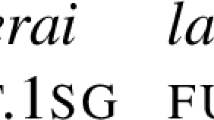Abstract
The notion of “lexeme” is central to realizational theoriesof morphology and to the notion of “morphology by itself”. Itis generally assumed that “inherent” inflections such as Pluralor Past Tense impart a meaning to the inflected word. However, this runs counterto the usual understanding of the notion “lexeme”, which is supposedto have a single constant meaning for all word forms. Since derivational morphologyis supposed to create new lexemes by adding a new component of meaning thismakes it difficult to distinguish in ection from derivation, which in turnundermines the whole lexeme concept. The problem evaporates if we assume thatsyntactic features are properties of phrases, not individual words, and thattheir semantic interpretation is therefore defined over phrasal expressions.This brings inflections on lexical heads into line with all otherexponents of functional features.
Similar content being viewed by others
References
Ackerman, F.-Webelhuth, G. 1998. A theory of predicates. Center for the Study of Language and Information, Stanford University.
Anderson, S.R. 1992. A-morphous morphology. Cambridge University Press, Cambridge.
Aronoff, M. 1994. Morphology by itself. MIT Press, Cambridge MA.
Beard, R. 1995. Lexeme morpheme base morphology. SUNY Press, Stony Brook NY.
Booij, G. 1994. Against split morphology. In: Booij, G.-van Marle, J. (eds): Yearbook of Morphology 1993, 27-49. Kluwer, Dordrecht.
Booij, G. 1996. Inherent versus contextual infection and the split morphology hypothesis. In: Booij, G.-van Marle, J. (eds): Yearbook of Morphology 1995, 1-16. Kluwer, Dordrecht.
Börjars, K.-Vincent, N.-Chapman, C. 1997. Paradigms, periphrases and pronominal in ection: a feature-based account. In: Booij, G.-van Marle, J. (eds): Yearbook of Morphology 1996, 155-80. Kluwer, Dordrecht.
Bresnan, J. in press. Lexical Functional Syntax. Blackwell, Oxford.
Bybee, J.L. 1985. Morphology: A study of the relation between meaning and form. John Benjamins, Amsterdam.
Halpern, A. 1995. On the placement and morphology of clitics. CSLI Publications, Stanford.
Haspelmath, M. 1996. Word-class-changing inflection and morphological theory. In: Booij, G.-van Marle, J. (eds): Yearbook of Morphology 1995, 43-66. Kluwer, Dordrecht.
Jackendo-, R.S. 1997. The architecture of the language faculty. MIT Press, Cambridge MA.
Matthews, P. 1972. Inflectional morphology. Cambridge University Press, Cambridge.
Ortmann, A. 1998. Where plural refuses to agree: feature unification or not? Talk given at the 8th International Morphology Meeting, Budapest, 11-14 June 1998. [Also in this volume]
Plank, F. 1994. Inflection and derivation. In: Asher, R.E. (ed.): The Encyclopaedia of Lan-guage and Linguistics, Vol. 3, 1671-8. Pergamon Press, Oxford.
Spencer, A. 1997. A note on the lexeme and the paradigm. Essex Research Reports in Linguistics 16: 1-16.
Spencer, A. 1999. Transpositions and argument structure. In: Booij, G.-van Marle, J. (eds): Yearbook of Morphology 1998, 72-102. Kluwer, Dordrecht.
Stump, G.T. 1993. Position classes and morphological theory. In: Booij, G.-van Marle, J. (eds): Yearbook of Morphology 1992, 129-79. Kluwer, Dordrecht.
Author information
Authors and Affiliations
Rights and permissions
About this article
Cite this article
Spencer, A. Inflection and the lexeme. Acta Linguistica Hungarica 47, 335–344 (2000). https://doi.org/10.1023/A:1014026901690
Issue Date:
DOI: https://doi.org/10.1023/A:1014026901690




